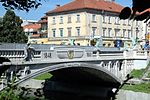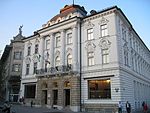Radiotelevizija Slovenija

Radiotelevizija Slovenija (English: Radio-Television of Slovenia) – usually abbreviated to RTV Slovenija (or simply RTV within Slovenia) – is Slovenia's national public broadcasting organization. Based in Ljubljana, it has regional broadcasting centres in Koper and Maribor and correspondents around Slovenia, Europe, and the world. RTV Slovenija's national radio services operate under the name Radio Slovenija, while the television division carries the name Televizija Slovenija or TV Slovenija. The names are sometimes Anglicized as Radio Slovenia and TV Slovenia, respectively. There are three national and four regional radio services, which can all be heard online as well. RTV Slovenija also finances the RTV Slovenia Symphony Orchestra and the RTV Slovenia Big Band. The legal foundation for the institution is the Radiotelevizija Slovenija Act (Slovene: Zakon o Radioteleviziji Slovenija). It is the only public nonprofit broadcasting organization in Slovenia to operate both radio and television stations. The law also requires it to air radio and television services for the country's two indigenous linguistic minorities, which it does in collaboration with the regional broadcasting centres in Maribor (for the Hungarian-speaking minority) and in Koper (for the Italian-speaking minority). Approximately 73% of RTV Slovenija's funding comes from television licence fees.
Excerpt from the Wikipedia article Radiotelevizija Slovenija (License: CC BY-SA 3.0, Authors, Images).Radiotelevizija Slovenija
Kolodvorska ulica, Ljubljana Trnovo
Geographical coordinates (GPS) Address Website External links Nearby Places Show on map
Geographical coordinates (GPS)
| Latitude | Longitude |
|---|---|
| N 46.054166666667 ° | E 14.508805555556 ° |
Address
Radiotelevizija Slovenija
Kolodvorska ulica
1000 Ljubljana, Trnovo
Slovenia
Open on Google Maps









